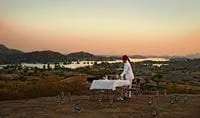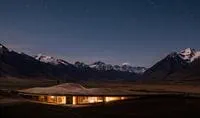Ecuador: Going beyond the Galapagos
Small but mighty, Ecuador is a fascinating nation, bursting at the seams with colour, culture and mouthwatering cuisine. Often overlooked as the gateway to the Galapagos, it is a fantastic destination in its own right, says Latin America expert, Scarlett.
25 June 2018

When one thinks of Ecuador, their mind often wanders to the Galapagos; a remote archipelago offering wildlife at every turn. Whilst an adventure to the Galapagos makes for the trip of a lifetime, what people don’t realise is that the Galapagos is just a tiny part of what this compact country has to offer. Straddled on the equator, Ecuador is home to the Amazonian rainforest, wild pacific beaches, misty highlands of the cloud forest and the dizzy heights of the Andes. Pair this with its colonial towns and cities, indigenous wealth and heartfelt people, there is an endless opportunity to explore.
For me, Ecuador encapsulates the true essence of what South America is all about and with its good roads and lovely hotels, there is no reason this country should go forgotten. After a recent trip, here are a few of my highlights which I feel should feature on every itinerary.
Often thought to be the gateway to the Galapagos, Quito is so much more than just that. It is the country’s capital, it is Latin America’s largest and best preserved colonial city and it affords a dramatic setting hemmed in between volcanic peaks. Built on the ruins of an Inca city, Quito’s old town is a maze of cobblestone streets, bustling markets, ancient monasteries, ornate churches and buzzing plazas owing it its UNESCO World Heritage status. Shamanic healers cleanse a queue of Quitenos in the neighbourhood of San Roque, indigenous women wrapped in embroidered shawls sell Ecuadorian sweets in the main plaza and chocolatiers show off their wares on the popular street of La Ronda. The culture and traditions are as well preserved as the architecture yet to really get under the skin of Quito, a city tour is the best way to do so. A trip to Ecuador should start with two to three nights in Quito and a stay should be spent at Casa Gangotena, a beautiful boutique hotel steeped in history and charm, perfectly located overlooking the San Francisco Plaza.
 Quito is a fantastic starting point for a holiday in Ecuador
Quito is a fantastic starting point for a holiday in Ecuador View over Quito
View over QuitoThe Amazon rainforest encompasses nearly half of Ecuador and is regarded as one of the 25 most bio-diverse spots in the world. It is easily accessible from Quito, only a 35-minute flight and 4-hour long boat ride along the river and is home to some excellent lodging options. When exploring the Ecuadorian Amazon, you will typically explore the Yasuni Biosphere Reserve, which is home to more than 610 bird species, at least 210 mammals and over 1,300 tree species.
 Bird in the Amazon, Ecuador
Bird in the Amazon, Ecuador Aerial view of the Amazon
Aerial view of the AmazonDuring any stay in the Amazon, you will spend time navigating the rainforest’s creeks and lagoons in a canoe, hiking the jungle trails or visiting the local Kichwa Ananguu community who will share with you the way they live and learn from there ancient relatives. A visit to the Parrot Clay Licks will be rewarded with sightings of several parrot and macaw species and climbing the 120ft canopy tower offers endless vistas across the rainforest and the chance to see sloths lazing in the trees. It’s important to note that unlike in the Galapagos, you are not tripping over wildlife in the Amazon and it takes a bit of patience – the longer you have the better your chances.
For those who love nature, wildlife and a bit of adventure then a stay here is a must on any visit to Ecuador and I would recommend staying three to four nights. I would recommend staying at Napo Wildlife Center which offers an incredible Amazon experience and is one of the most comfortable lodges in the Amazon. It is also one of only eco-lodges to be located within the Yasuni National Park and so offers one of the best places to maximise your wildlife spotting opportunities. During my stay I stayed in a suite cabana, which offers more space, a lake view and from which, I was lucky enough to spot caiman from the terrace, some turtles and an array of bird species.
 Napo Wildlife Center
Napo Wildlife Center Napo Wildlife Center
Napo Wildlife CenterThe Andes form the backbone of Ecuador, running all the way from the north to the south of the country and offer dramatic landscapes, indigenous towns and deep-rooted culture and traditions. Just two hours north of Quito in the heart of the Andes lies the most charming hacienda known as Zuleta. This is a must on any visit to Ecuador and probably one of my favourite places in Latin America. Set deep in the valley, the extensive grounds of the property are surrounded by miles of rural green pastures, primary forest and local communities. The location is breath-taking and perfect for those who love the outdoors, mountainous landscapes and want to experience an authentic slice of Ecuadorian hospitality. Dating back to 1691, the Hacienda is steeped in colonial charm and character. Originally owned by the Ex-president Gallo Plaza Lasso, it is now run by his 5 daughters and their children and so there is a big family presence and an incredible amount of history, which is evident around the hacienda today. They live on extensive grounds so time can be spent on numerous hiking trails, mountain biking, visiting the surrounding local communities or town of Otavalo know well known for its talented weavers and colourful textiles. They also have their own breed of horses and offer what I think to be the best riding in the country and suitable for all abilities. A stay here is the perfect way to round up your experience in Ecuador and I would stay for no less than three nights if you can.
 Hiking in Ecuador's Central Highlands
Hiking in Ecuador's Central Highlands Scarlett horseriding in Ecuador
Scarlett horseriding in EcuadorIf it isn’t already, the Galapagos should be on everyone’s wish list. It truly is a very special place and rightly coined by Charles Darwin as a ‘little world within itself’. This cluster of volcanic islands is home to many unique species found nowhere else in the world. Wildlife here is abundant and fearless and time is spent observing these creatures from just a few metres away. For me the best way to really get under the skin of the Galapagos is on a cruise and I would recommend anything between four to seven nights. Our portfolio of boats ranges from 16 passenger vessels right up to 100 passenger vessels and each size comes with its advantages and disadvantages so it is important to determine what works for you. I was lucky enough to experience four nights on the M/V Santa Cruz, a 90-passenger ship (with only 46 passengers on board) which offered more stability than a smaller boat, and, due to the regulations of the park, most landing sites were exclusive to the Santa Cruz. The boat also offered a great guide to guest ratio of only one guide per twelve people. The only one thing a cruise does not allow for is flexibility.
Itineraries are structured to abide by the rules of the National Park and to ensure you get the most out of the experience and so if you’re looking for more of a relaxed way to explore the Galapagos, I would recommend looking at a land based option and staying in a hotel on one of the islands. Staying in a hotel, you can still get a feel for the destination, see lots of wildlife and have more flexibility on how you spend your time. My favourite place to stay was the Finch Bay Eco Hotel as it boasted a great location on the island of Santa Cruz with a beach front location and large outdoor pool, offered a number of day trips to the nearby islands and was the perfect spot to relax when not out exploring.
 Scarlett with a Giant Tortoise
Scarlett with a Giant Tortoise Up close with the wildlife of the Galapagos
Up close with the wildlife of the GalapagosOther blogs you may also be interested in...
Why Scott Dunn?
Unique to You

- We listen to your travel goals and craft unique trips that are bespoke to you.
- We’re with you every step of your life’s travel journey, from honeymoons to family trips and beyond.
Seamless Service

- Global offices in the UK, US, and Singapore for 24/7 seamless service.
- We offer flexibility if your plans change so you can book with confidence and peace of mind.
Carefully Curated Collection

- We’ve curated an elevated collection of accommodation, experiences, and guides.
- Committed to fostering close global relationships to continue bringing you unique experiences.
Luxury in Every Sense

- We deliver a sense of luxury that matters most to you.
- Awarded Condé Nast Traveller’s Top Travel Specialists in the World 12 years in a row.







